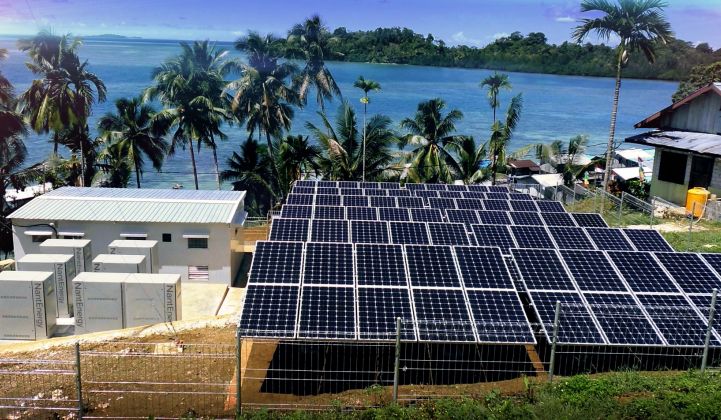The company formerly known as Fluidic has two things that no other alternative battery startup has achieved: thousands of systems deployed and financial security.
The company chugged along, quietly churning out zinc-air batteries for remote deployments overseas, while those making flow batteries, saltwater batteries and miniaturized compressed air batteries ran out of money.
Then, early this year, Fluidic found a strong backer: Patrick Soon-Shiong, the billionaire who recently acquired the Los Angeles Times, bought a majority stake for an undisclosed amount. The company had raised a total of $220 million to date.
“We felt that, to scale the company to gigawatt-hour production capability and expand to multiple product lines and multiple markets, we wanted somebody who has access to capital and can bring a lot of influence in terms of direction and vision,” said CTO Ramkumar Krishnan.
With its financial sustainability squared away, newly rebranded NantEnergy has prioritized building a full-scale manufacturing facility of at least 1 gigawatt-hour production capacity, planned to open in California next year. It’s also looking for regional manufacturing partners overseas.
The company says it can hit the price point of $100 per kilowatt-hour once it scales up production to about 100 megawatts, which should happen next year. That price point, a near-mythical goal for the industry, would be well below what mass-produced lithium-ion storage currently achieves.
“Our cost is already there,” Krishnan said. “Now it’s all about getting the right partners and scaling and getting the right momentum and rhythm to continue.”
Steel in the ground (or zinc in the air?)
The common refrain from challengers to lithium-ion's storage hegemony goes something like this: We’ve got a safer, longer-duration, longer-lived technology, and it’ll be cheaper too — once we get up to scale.
The problem there is that lithium-ion is already producing at massive scale, trending even more massive, while the alternative startups have a pesky tendency to run out of money with just a handful of installations operating in the field.
NantEnergy offers a rare counterexample.
Over the last six years, it has installed 3,000 zinc-air battery systems in nine different countries, where they performed a cumulative 1.2 million cycles, Krishnan said. That amounts to approximately 55 megawatt-hours of installed capacity.
Rather than chasing pilot projects and infant industry subsidies in the tricky U.S. market, Fluidic picked two overseas markets where it could compete on cost: telecom backup and remote microgrids.
Its factory in Indonesia supplied the surrounding region, but the company also has nearly 1,000 units in Latin America, Krishnan said.
Some 110 communities, totaling 200,000 people, get 100 percent renewable-based electricity with microgrids backed by NantEnergy batteries, he added.
The company has since spun off the Indonesia factory as an independent licensed regional manufacturer.
NantEnergy expanded its offerings to include hybrid systems that pair long-duration zinc-air with technologies for shorter-term power delivery, including ultracapacitors and lithium-ion.
“No one technology is going to solve all the grid challenges and market needs,” Krishnan said.
Growth opportunities
As the new manufacturing gets up and running, NantEnergy has some new target markets to explore. Its presence in Africa and the U.S. is still early stage.
Duke Energy chose NantEnergy for its remote microgrid to power an outpost in the Great Smoky Mountains National Park, and NantEnergy has also delivered a telecom application in California, Krishnan said. Otherwise, it hasn’t broken into its home country yet.
There’s plenty of room to grow in the telecom backup storage application, which amounts to a $7 billion market worldwide, Krishnan said. It's projected to grow to $11 billion by 2022. Even capturing a fraction of that would make for a lucrative storage business.
Then there’s the data center market, which could tap gigawatt-hours a year for a single customer, Krishnan said.
Not bankruptcy yet
The long-duration storage sector has delivered a string of bankruptcies and little outstanding success. It’s incumbent upon NantEnergy to explain why its product will play out differently.
The first task is to build a product that can feasibly beat lithium-ion on price, given the incumbent’s head start down the cost curve.
Aquion tried to do that with saltwater batteries, but ran out of money. So did LightSail, after sinking $80 million into tanks for compressed air storage. Flow batteries hold the potential for cheap, long lasting storage, but they haven’t reached large-scale commercial deployment.
The materials cost of vanadium flow batteries, one prominent varietal, doesn’t bode well for beating lithium-ion, Krishnan said. Working with zinc and air, on the other hand, keeps active materials costs very low.
A good design doesn’t matter unless customers actually want to try it. Many of the contenders get a few pilots up, and then run out of steam waiting for sufficient run-time to prove their worth to bigger customers.
“No one wants to be the first one to buy a brand-new technology or product,” Krishnan said.
NantEnergy racked up several thousand deployments by going to extreme settings where it could beat the incumbent technology on cost, even before scaling up production. Zinc-air battery microgrids fare well against imported diesel for powering remote islands, or against old-school lead acid batteries for telecom backup.
Whether NantEnergy can win a contract for grid-scale peaker plant replacement on the U.S. grid is another question. At the very least, the startup now can worry less about its runway while finding the answer.
***
Now in its fourth year, GTM's Energy Storage Summit will bring together utilities, financiers, regulators, technology innovators and storage practitioners for two full days of data-intensive presentations, analyst-led panel sessions with industry leaders, and extensive, high-level networking. This year, we're expanding our traditionally U.S.-focused event to cover the global market. Learn more here.




